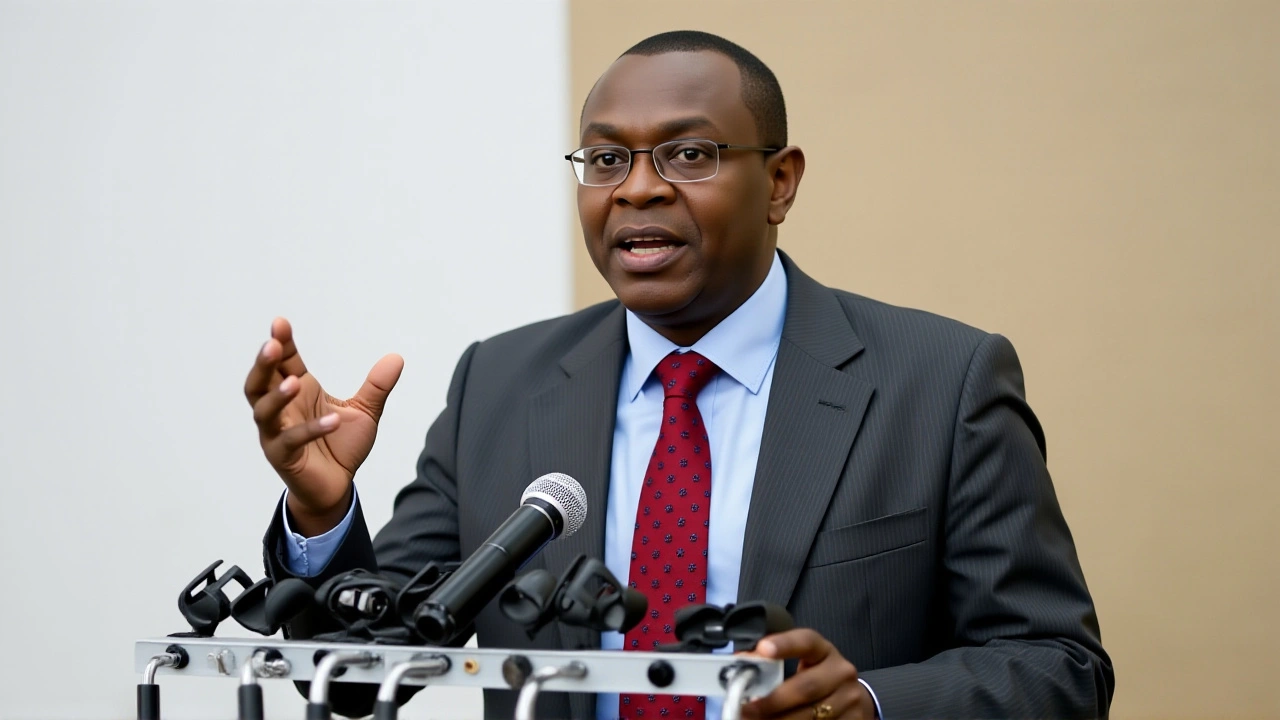
When Kenya National Examinations Council (KNEC) opened its new competency-based assessment portal, schools across the country suddenly had a digital doorway to register Grade 3 and Grade 6 learners for the 2025 testing cycle. The site – reachable at cba.knec.ac.ke – is the official hub for feeding learner data into the upcoming Kenya Primary School Education Assessment (KPSEA) and Kenya Intermediate Level Education Assessment (KILEA).
Why the CBA Portal Matters Now
The Kenyan education system is in the middle of a historic shift from the old rote‑based exams to a competency‑based curriculum. That transition began in 2022, and each year the council adds another level of the new assessment ladder. By 2025, the KPSEA for lower primary (Grade 3) and the KILEA for upper primary (Grade 6) are the two critical checkpoints. Without a reliable registration channel, schools risk missing the national deadline, which could push learners into a year‑long backlog.
According to the Ministry of Education, the registration window opened on 1 March 2025 and will stay open until 30 April 2025. The tight timeline forces both school administrators and parents to act quickly, otherwise the learners’ assessment results could be delayed or even invalidated.
How the Portal Works: A Step‑by‑Step Walkthrough
First, every school must secure its unique KNEC Code. This identifier doubles as the portal username and is issued by the Area Sub‑County Director of Education (SCDE) in the school’s jurisdiction. Once the code is in hand, the school receives a password that unlocks the dashboard.
Once logged in, administrators see a clean interface with two main tabs: “Grade 3 Registration” and “Grade 6 Registration.” Clicking either tab reveals a “Register Learners” button. From there, the user can upload an Excel template (provided on the portal) or enter each learner’s details manually – name, date of birth, national ID, and parent contact information.
After submission, the system validates the data against the national learner database. Any mismatches – say, a missing ID number – trigger an on‑screen alert, prompting the school to correct the entry before the final lock‑in on 30 April.
Who Needs to Be Involved?
KPSEANairobi and KILEANairobi will be administered centrally from KNEC’s headquarters in Nairobi, but the heavy lifting happens locally.
Schools – headteachers, ICT officers, and the designated registration officer – must double‑check every learner’s information. A single typo in a national ID can send a child’s results to the wrong file, creating headaches for both parents and the council.
Parents – the ultimate beneficiaries – are urged to review the printed summary sheets that schools distribute after the upload. The council’s flyer, circulating in local radio spots, repeats the mantra: “Check twice, register once.”
SCDEs – acting as the bridge between schools and KNEC – handle password resets, code re‑issues, and any on‑ground troubleshooting. The council’s hotline, 020‑321‑6789, routes callers directly to the nearest SCDE office.

Common Pitfalls and How to Avoid Them
- Using an outdated KNEC Code – always confirm the code with the SCDE before the first login.
- Uploading the Excel template with hidden formulas – the portal strips out anything that isn’t pure data, which can corrupt the file.
- Missing the 30 April lock‑in – the system goes read‑only at midnight, so plan to finish a week early.
- Neglecting to verify parent contact numbers – this slows down any follow‑up SMS alerts the council sends about exam dates.
Schools that encounter technical glitches are explicitly told not to try “DIY” fixes. Instead, they should contact their SCDE, who can liaise with KNEC’s IT unit. The council has warned that unauthorized attempts to tamper with the portal could lead to data breaches and, in extreme cases, sanctions against the school.
What This Means for Kenya’s Education Future
The launch of the CBA portal is more than a bureaucratic update; it’s a litmus test for Kenya’s digital transformation in education. If the registration runs smoothly, the data collected will feed into the national analytics platform that tracks learner competency trends across counties. Those insights will shape teacher training programs, resource allocation, and even future curriculum revisions.
Conversely, widespread registration errors could erode confidence in the competency‑based system, prompting calls for a fallback to the old KCPE model. That would be a step backward, especially as the government has earmarked $2.3 million for digital infrastructure upgrades in schools over the next three years.

Looking Ahead: Key Dates to Remember
Beyond the 30 April registration deadline, stakeholders should mark the following milestones:
- 1 May 2025 – KPSEA testing window opens (first week of May).
- 15 May 2025 – KPSEA results released to schools.
- 1 August 2025 – KILEA testing window begins.
- 15 August 2025 – KILEA results disseminated.
- 30 September 2025 – KNEC publishes national competency reports.
These dates give teachers and parents a clear roadmap, but they also underscore why timely registration is non‑negotiable.
Frequently Asked Questions
How can parents verify that their child's information was entered correctly?
After the school submits the batch, it prints a confirmation sheet for each learner. Parents should compare this sheet with the original enrollment form and flag any discrepancies to the school’s registration officer before 25 April.
What is the deadline for completing the registration?
The portal locks for new entries at 23:59 GMT on 30 April 2025. Schools can still view submitted data after that date, but no changes are allowed.
What should a school do if it forgets its password?
The school must contact its Area Sub‑County Director of Education, who will verify the institution’s identity and issue a new password. The SCDE can also reset passwords remotely via the KNEC support portal.
How does the competency‑based assessment differ from the old KCPE?
Instead of focusing solely on memorisation, the new system evaluates learners on practical skills, problem‑solving, and application of knowledge. Scores are reported as competency levels rather than a single percentage, allowing a more nuanced view of each pupil’s strengths.
Who should schools contact for technical issues with the portal?
Technical problems must be routed through the Area SCDE, who in turn liaises with KNEC’s IT help desk. Direct attempts to modify the portal’s code are prohibited and could result in disciplinary action.
12 Comments
Tracee Dunblazier
October 19 2025
Honestly, the portal looks slick, but I can’t help noticing how many schools might still stumble on the basics. If you miss a single ID digit, you’ll be chasing ghosts for weeks. It’s a classic case of ‘new tech, same old headaches.’
Edward Garza
October 24 2025
Looks like another bureaucratic nightmare.
Allen Rodi
October 29 2025
From experience, double‑checking the Excel upload for hidden formulas saves a lot of back‑and‑forth with the SCDE. Also, keep a backup CSV just in case the portal throws an unexpected error.
Jody Webster
November 3 2025
Wow-so many dates!!! 1 March to 30 April… Make sure you write them down; you’ll thank me later… ;)
Steve Goodger
November 8 2025
Let me take a moment to unpack why this portal is more than just a digital form filler. First, the very concept of a centralized, competency‑based registration system signals a shift in how we view learner data-not merely as a bureaucratic requirement but as a strategic asset for educational planning. By aggregating accurate birth dates, national IDs, and parental contacts, the Ministry can map demographic trends across counties, identifying regions where interventions are most needed. Second, the portal’s validation engine, which cross‑references entries against the national learner database, dramatically reduces the risk of misallocation of results-a problem that plagued previous cohorts when typo‑laden sheets were processed manually. Third, the requirement for schools to secure a unique KNEC code reinforces accountability; each institution now has a traceable digital footprint for the submission process. Fourth, the clear deadline of 30 April, coupled with a read‑only lock‑out at midnight, creates a definitive cut‑off that encourages schools to plan their data collection well in advance, rather than scrambling at the last minute. Fifth, the portal’s design accommodates both bulk uploads via the Excel template and manual entry, offering flexibility for schools with varying levels of ICT infrastructure. Sixth, the emphasis on parent verification-through printed confirmation sheets-empowers families to take ownership of their children’s records, fostering a culture of transparency. Seventh, the integration of SMS alerts ensures that any changes or important announcements reach parents promptly, bridging the communication gap that often exists between schools and households. Eighth, the portal’s architecture sets a precedent for future digital initiatives, such as e‑report cards or online teacher training modules. Ninth, by centralizing data, the government can more efficiently allocate the $2.3 million earmarked for digital upgrades, targeting schools that demonstrate readiness and effective use of the system. Tenth, the portal also serves as a pilot for data security protocols, teaching administrators the importance of safeguarding personal information. Eleventh, this move aligns Kenya with global trends towards competency‑based education, positioning the country as a leader in Sub‑Saharan Africa. Twelfth, it offers an opportunity for researchers to analyze competency trends over time, potentially influencing curriculum development. Thirteenth, schools that master this process will likely see smoother transitions into subsequent assessment cycles, such as the KILEA for Grade 6. Fourteenth, the portal provides a single point of contact for technical support via the SCDE, reducing confusion over where to seek help. Fifteenth, the public nature of the rollout, with radio spots and flyers, helps build community awareness. In short, the CBA portal is a cornerstone for the broader digital transformation of Kenya’s education system, and its success hinges on meticulous data entry, proactive parent involvement, and robust support from SCDEs.
johnson ndiritu
November 13 2025
Wow, KNEC really thinks they’re the tech gods now 😂. Uploading an Excel file sounds simple until the portal decides to reject it for “hidden formulas”. Good luck fixing that without calling in the “IT crowd”.
sheri macbeth
November 18 2025
Sure, a shiny portal will solve everything-just like the moon landing solved traffic jams. Maybe next they’ll invent a magic wand to erase all the paperwork.
Lane Herron
November 23 2025
Let me break down the labyrinthine complexities of this “new” system: it’s a veritable Byzantine tapestry of data fields, validation checks, and lock‑in protocols that would make even a seasoned systems architect weep. The portal’s UI, while ostensibly sleek, obfuscates critical error messages behind a veneer of pastel gradients, thereby necessitating a PhD in cognitive ergonomics to decipher. Moreover, the reliance on real‑time database cross‑referencing introduces latency spikes that could, under peak load, cause temporal dissonance across the registration timeline. In short, proceed with caution, dear educators.
Henry Cohen
November 28 2025
Everyone’s acting like this portal is flawless, but have you considered that the KNEC code might be outdated for half the schools? Plus, the Excel template often has hidden cells that mess everything up. Just saying.
Mark Langdon
December 3 2025
I understand the frustration, but let’s stay constructive. If you run into a technical snag, reaching out to your SCDE is the fastest way to get assistance. They’ve handled these issues before and can guide you through the reset process.
Ciara Russell-Baker
December 9 2025
Honestly, this portal is just another way for the gov’t to collect data. Not impressed.






Brandon Rosso
October 14 2025
Congratulations to KNEC for rolling out the CBA portal! This is a significant stride toward modernizing Kenya's assessment framework. Schools should take advantage of the clear interface and ensure all learner data is entered accurately before the April deadline. Let’s keep the momentum going and support a smooth registration process for our kids.